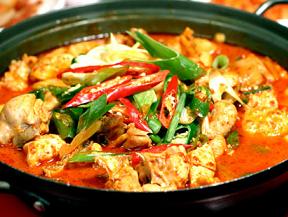Ingredients:
- 3 1/2 cups Kimbap rice
- 3 sheets roasted seaweed
- 140g lean beef
- 1 small cucumber
- 60g carrot
- 7 dried mushrooms
- 2 eggs, beaten
A:
- 2 T soy sauce
- 1 T sesame oil
- 1 t sugar
- 1/2 t cooking wine
- Crushed garlic, roasted sesame seeds, finely chopped green onion
B:
- 1 t sugar
- 1/4 t salt
- Salad oil, salt and pepper
- 3 1/2 cups Kimbap rice
- 3 sheets roasted seaweed
- 140g lean beef
- 1 small cucumber
- 60g carrot
- 7 dried mushrooms
- 2 eggs, beaten
A:
- 2 T soy sauce
- 1 T sesame oil
- 1 t sugar
- 1/2 t cooking wine
- Crushed garlic, roasted sesame seeds, finely chopped green onion
B:
- 1 t sugar
- 1/4 t salt
- Salad oil, salt and pepper
Directions:
Put cooked rice into mixing tub and sprinkle vinegar mixture generously over rice. With a large wooden spoon, mix with a slicing motion. While you mix, have a helper,(electric fan). This is not to cool kimbap rice, but to puff the extra liquid away.
* Procedures
1. Cut beef into strips.
2. Combine A; add beef to marinate.
3. Halve cucumber lengthwise, then but into thin diagonal slices. Sprinkle with salt, let stand until soft; squeeze out water.
4. Cut carrot into 2 in (5cm) long strips.
5. Soak dried mushrooms in lukewarm water until soft. Discard stems and slice thinly.
6. Heat salad oil in a skillet and cook beef over high heat; set aside. Likewise stir-fry each ingredient lightly and season with salt and pepper.
7. Mix egg and B well. Pour over lightly greased square omelet pan thinly.
8. When half-set, roll from far aside tightly. When golden brown, remove from heat.
9. Cut lengthwise in three.
10. Lay seaweed over bamboo mat. Spoon over 1/3 amount (1 1/6 cups) evenly. Wet your fingers with vinegared water and press gently.
11. Leave 1/2 in (1.5 cm) on your side, 1 in (2.5 cm) on far side uncovered.
12. Arrange beef, cucumber, mushrooms, carrot and egg omelet in contrasting colors slightly below center.
13. Holding edges of fillings, roll in one motion so the uncovered seaweed meet each other.
14. Roll up and shape. Press ends.
15. Cut each roll into 8. Wipe the knife with wet cloth after each slice. Arrange on a plate cut side up.



